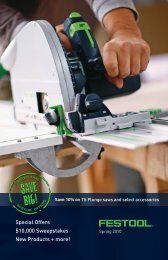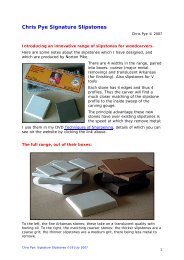Joiner and - Tools for Working Wood
Joiner and - Tools for Working Wood
Joiner and - Tools for Working Wood
You also want an ePaper? Increase the reach of your titles
YUMPU automatically turns print PDFs into web optimized ePapers that Google loves.
planed. Having planed straight one side of the board which he wants to<br />
square, Thomas lays it upon the shooting-board with the straight edge<br />
close along the cross piece, <strong>and</strong> holds it steady with his left h<strong>and</strong>. The end<br />
to be planed square hangs a little over the edge of the shooting-board;<br />
<strong>and</strong> against this end Thomas works the face of the plane, which <strong>for</strong> this<br />
purpose is laid on its side on the bench. Here again the jack is used first<br />
to take off the roughness left by the saw, <strong>and</strong> the trying-plane to finish<br />
the work up square. In planing cross-grain in this way, great care must<br />
be taken not to split off a little piece at each side, <strong>and</strong> the planes must<br />
be kept very sharp <strong>and</strong> set very fine. To do this well requires a good deal<br />
of practice; Thomas, we know, has had a good deal, <strong>and</strong> he manages at<br />
length to make his sides square <strong>and</strong> exactly of the same size, so as to fit<br />
which ever way he turns them; <strong>and</strong> so likewise his ends. This is a matter of<br />
importance, as the box will not be square unless it be carefully attended<br />
to.<br />
“And now <strong>for</strong> dovetailing the corners,” says Thomas, half afraid<br />
to attempt so large a joint, <strong>for</strong> as yet he has practised only on smaller<br />
pieces; but the same care <strong>and</strong> attention which make a good joint with<br />
small pieces will also with large ones. The gauge was set be<strong>for</strong>e to the<br />
exact thickness of the pieces <strong>for</strong> the sides <strong>and</strong> ends of the box; with this,<br />
Thomas in the first place makes a clear but faint 29 mark all across each<br />
end of his four pieces, both inside <strong>and</strong> out. He then begins to dovetail<br />
one corner of the box; suppose it to be the one nearest to us in fig. 2, [p.<br />
<br />
<br />
fi<br />
<br />
fifi<br />
fifl<br />
<br />
<br />
fi<br />
fi<br />
<br />
<br />
<br />
fl<br />
fi<br />
fi<br />
<br />
fi













